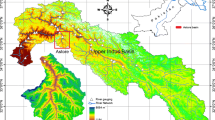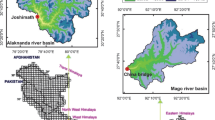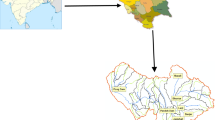Abstract
Air temperature and snow cover variability are sensitive indicators of climate change. This study was undertaken to forecast and quantify the potential streamflow response to climate change in the Jhelum River basin. The implications of air temperature trends (+0.11°C/decade) reported for the entire north-west Himalaya for past century and the regional warming (+0.7°C/decade) trends of three observatories analyzed between last two decades were used for future projection of snow cover depletion and stream flow. The streamflow was simulated and validated for the year 2007–2008 using snowmelt runoff model (SRM) based on in-situ temperature and precipitation with remotely sensed snow cover area. The simulation was repeated using higher values of temperature and modified snow cover depletion curves according to the assumed future climate. Early snow cover depletion was observed in the basin in response to warmer climate. The results show that with the increase in air temperature, streamflow pattern of Jhelum will be severely affected. Significant redistribution of streamflow was observed in both the scenarios. Higher discharge was observed during spring-summer months due to early snowmelt contribution with water deficit during monsoon months. Discharge increased by 5%–40% during the months of March to May in 2030 and 2050. The magnitude of impact of air temperature is higher in the scenario-2 based on regional warming. The inferences pertaining to change in future streamflow pattern can facilitate long term decisions and planning concerning hydro-power potential, water resource management and flood hazard mapping in the region.
Article PDF
Similar content being viewed by others
Avoid common mistakes on your manuscript.
References
Ageta Y (2001) Study project on the recent shrinkage of summer accumulation type glaciers in the Himalayas, 1997–1999. Bulletin of Glaciological Research 18: 45–49.
Archer DR, Fowler HJ (2008) Using meteorological data to forecast seasonal runoff on the River Jhelum, Pakistan. Journal of Hydrology 361: 10–23. DOI: 10.1016/j.jhydrol.2008.07.017
Arora M, Singh P, Goel NK, et al. (2008) Climate variability influences on hydrological responses of a large Himalayan basin. Water Resource Management 22: 1461–1475. DOI: 10.1007/s.11269-007-9237-1
Beniston M (1997) Variation of snow depth and duration in the Swiss Alps over the last 50 years: Links to changes in largescale climatic forcings. Climatic Change 36: 281–300. DOI: 10.1023/A:1005310214361
Beniston M (2003) Climatic change in mountainous regions: a review of possible impacts. Climate Change 59: 5–31. DOI: 10.1023/A:1024458411589
Bhutiyani MR, Kale VS, Pawar NJ (2007) Long-term trends in maximum, minimum and mean annual air temperatures across the northwestern Himalaya during the 20th Century. Climatic Change 85: 159–177. DOI: 10.1007/s10584-006-9196-1
Bhutiyani MR, Kale VS, Pawar NJ (2008) Changing streamflow patterns in the rivers of northwestern Himalaya: Implications of global warming in the 20th century. Current Science 95(5): 618–626.
Bhutiyani MR, Kale VS, Pawar NJ (2009) Climate change and the precipitation variations in the north-western Himalaya: 1866–2006. International Journal of Climatology DOI: 10.1002/joc.1920.
Borgaonkar HP, Pant GB, Kumar R (1996) Ring-width variations in Cedras deodara and its climatic response over the western Himalaya. International Journal of Climatology 16: 1409–1422. DOI: 10.1002/(SICI)1097-0088(199612)16:12〈1409::AID-JOC93〉3.0.CO;2-H
Butt M, Bilal M (2011) Application of snowmelt runoff model for water resource management. Hydrological Processes 25(24): 3735–3747. DOI: 10.1002/hyp.8099.
Cannone N, Diolaiuti G, Gugliemin M, et al. (2008) Accelerating climate change impacts on alpine glacier forefield ecosystems in the European alps. Ecological Application 18(3): 637–648. DOI: 10.1890/07-1188.1
Crowley TJ (2000) Causes of climate change over the past 1000 years. Science 289: 270–276. DOI: 0.1126/science.289.5477.270
Day CA (2009) Modelling impacts of climate change on snowmelt runoff generation and streamflow across western US mountain basins: a review of techniques and applications for water resources management. Progress in Physical Geography 33(5): 614–633. DOI: 10.1177/0309133309343131
De US, Mukhopadhyay RK (1998) Severe heat wave over the Indian subcontinent in 1998, in perspective of global climate. Current Science 75(12): 1308–1311.
Diaz HF, Bradley RS (1997) Temperature variations during the last century at high elevation sites. Climatic Change 36: 253–279. DOI: 10.1023/A:1005335731187
Diaz HF, Grosjean M, Graumlich L (2003) Climate variability and change in high elevation regions: past, present and future. Climatic Change 59: 1–4. DOI: 10.1023/A:1024416227887
Easterling DR, Horton B, Jones PD, et al. (1997) Maximum and minimum temperature trends for the globe. Science 227: 364–365.
Fallot JM, Barry RG, Hoogstrate D (1997) Variation of mean cold season temperature, precipitation and Snow depths during the last 100 years in the former depths during the last 100 years in the former Soviet Union (FSU). Hydrological Sciences 42: 301–327.
Hall DK, Riggs GA, Salomonson VV, et al. (2002) MODIS snow cover products. Remote Sensing of Environment 83: 181–194.
Hewitt K (2005) The Karakoram anomaly Glacier expansion and the ‘elevation effect,’ Karakoram Himalaya. Mountain Resource Development 25(4): 332–340. DOI: 10.1659/0276-4741(2005)025[0332:TKAGEA]2.0.CO;2
Huber UM, Bugmann HKM, Reasoner AM (2005) Global Change and Mountain Regions: An Overview of Current Knowledge. Advances in Global Change Research series 23: 650 ISBN 978-1-4020-3508-1.
IPCC, Climate change (2001) The IPCC Third Assessment Report, Vols I (The scientific basis), II (Impacts, adaptation and vulnerability) and III (Mitigation), Cambridge University Press, Cambridge.
IPCC (2007) Climate Change 2007: Climate Change Impacts, Adaptation and Vulnerability, Working Group II Contribution to the Intergovernmental Panel on Climate Change - Fourth Assessment Report Summary for Policymakers.
Jain SK, Goswami A, Saraf A (2009) Snowmelt runoff modeling in a Himalayan basin with the aid of satellite data. International Journal of Remote Sensing 31: 6603–6618. DOI: 10.1080/01431160903433893
Jain SK, Goswami A, Saraf A (2010) Assessment of Snowmelt Runoff Using Remote Sensing and Effect of Climate Change on Runoff. Water Resources Management 24: 1763–1777. DOI: 10.1007/s11269-009-9523-1
Jones PD, Raper SCB, Bradley RS, et al. (1986) Northern hemispheric surface air variation: 1851–1984. Journal of Climate and Applied Meteorology 25: 161–179.
Jones PD, Raper SCB, et al. (1986) Southern hemispheric surface air variation: 1851–1984. Journal of Climate and Applied Meteorology 25: 1213–1230.
Karl TR, Knight RW, Plummer N (1995) Trends in high frequency climate variability in the twentieth century. Nature 377: 217–220. DOI: 10.1038/377217a0
Knappenberger PC, Michaels PJ, Davis RE (2001) Nature of observed temperature changes across the United States during the 20th century. Climate Research 17: 45–53. DOI: 10.3354/cr017045
Larson RP, Byrne JM, Johnson DL, et al. (2011) Modelling climate change impacts on spring runoff for the rocky mountains of Montana and Alberta I: Model development, calibration and historical analysis. Canadian Water Resource Journal 36(1): 17–34.
Li C, Tang M (1986) Changes of air temperature of Qinghai-Xizang plateau and its neighbourhood in the past 30 years. Plateau Meteorology 5: 322–341.
Lin YP, Hong, NM, Wu PJ et al. (2007) Modeling and assessing landuse and hydrological processes to future land-use and climate change scenarios in watershed land-use planning. Environmental Geology 53: 623–634 DOI: 10.1007/s00254-007-0677-y.
Martinec J, Rango A, Roberts R (2008) Snowmelt Runoff Model (SRM) User’s Manual (version 1.11). Available online at: http://hydrolab.arsusda.gov/cgi-bin/srmhome/srm4.pdf (accessed in November 2012)
Meng L, Tao L, Li J, et al. (2008) A system for automatic processing of MODIS L1B data. 8th International Symposium on spatial accuracy assessment in Natural Resources and Environmental Sciences, June 2008, Shanghai, China. pp 335–343.
Negi HS, Snehmani, Thakur NK (2008) Operational Snow Cover Monitoring in NW-Himalaya using Terra and Aqua MODIS Imageries. Proceedings International Workshop on Snow, Ice, Glacier and Avalanches, IITMumbai, India, 7–9 January 2008. pp 11–25.
Nichol J, Hang LK, Sing WM (2006) Empirical correction of low sun angle images in steeply sloping terrain: a slope matching technique. International Journal of Remote Sensing 27(3–4): 629–635.DOI: 10.1080/02781070500293414
Mishra VD, Sharma JK, Singh KK, et al. (2009) Assessment of different topographic corrections on AWiFS satellite imagery of Himalaya terrain. Journal of Esrth System and Science 118(1) 11–26.
Oerlemans J (1994) Quantifying global warming from retreat of glaciers. Science 264: 243–245.
Pant GB, Borgaonkar HP (1984) Climate of the hill regions of Uttar Pradesh. Himalayan Research and Development 3(1): 13–20.
Pant GB, Borgaonkar HP, Kumar R (1999) Climate variability over the Western Himalaya since little ice age: dendroclimatic implications. In Proceedings of national snow science workshop “Technology in support of snow and avalanche research”, Manali (India), October 1999.
Qiang F, Celeste MJ, Stephen GW, et al. (2004) Contribution of stratospheric cooling to satellite inferred tropospheric temperature trends. Nature 429: 55–57. DOI: 10.1038/nature02524
Riggs H, Hall DK (2002) Reduction of cloud obscuration in the MODIS snow data product. In Proceedings of 59th Eastern Snow conference, Stowe, Vermont USA, June 2002.
Rebetez M (2004) Summer 2003 maximum and minimum daily temperature over a 3300 m altitudinal range in the Alps. Climate Research 27: 45–50.
Schaer C, Vidale PL, Luthi D, et al. (2004) The role of increasing temperature variability in European summer heat waves. Nature 427: 332–336. DOI: 10.1038/nature02300
Seko K, Takahashi S (1991) Characteristics of winter precipitation and its effects on glaciers in Nepal Himalaya. Bulletin of Glacier Research 9: 9–16.
Sharma SS, Ganju A (2000) Complexities of avalanche forecasting in western Himalaya - an overview. Cold Region Science and Technology 31: 95–102.
Sharma V, Mishra VD, Joshi PK (2012) Snow cover variation and streamflow simulation in a snow-fed river basin of the Northwest Himalaya. Journal of Mountain Science 9: 853–868 DOI: 10.1007/s11629-012-2419-1.
Shekhar MS, Chand H, Kumar S, et al. (2010) Climate-change studies in the western Himalaya. Annals of Glaciology 51(54): 105–112. DOI: 10.3189/172756410791386508
Singh P, Bengtsson L, Berndtsson R (2003) Relating air temperatures to the depletion of snow covered area in a Himalayan Basin. Nordic Hydrology 34(4): 276–283. DOI: 10.2166/nh.2003.016
Singh P, Bengtsson L (2004) Hydrological sensitivity of a large Himalayan basin to climate change. Hydrological Processes 18 2363–2385, DOI: 10.1002/hyp.1468.
Thompson LG, Yao T, Mosley-Thompson E, et al. (2000) A high-resolution millennial record of the South Asian monsoon from Himalayan ice cores. Science 289: 1916–1919. DOI: 10.1126/science.289.5486.1916
Villaba R, Lara A, Boninsegna JA, et al. (2003) Large scale temporal changes across the southern Andes: 20th century variations in the context of the past 400 years. Climatic Change 59: 177–232.
Vinnikov K, Graisman P. Ya, Lugina KM (1990) Empirical data on contemporary global climatic changes (Temperature and Precipitation). Journal of Climate 3: 662–677. DOI: 10.1175/1520-0442(1990)003〈0662:EDOCGC〉2.0.CO;2
Vuille M, Bradley RS, Werner M, et al. (2003) 20th Century climate change in the tropical Andes: observations and model results. Climatic Change 59: 75–99. DOI: 10.1007/978-94-015-1252-7_5
Wang J, Li HY, Hao XH (2010) Reponses of snowmelt runoff to climatic change in an inland river basin, Northwestern China, over the past 50a. Hydrological Earth System and Sciences Discussions 7: 493–528.
Wibig J, Glowicki B (2002) Trends in minimum and maximum temperature in Poland. Climate Research 20: 123–133.
Zhai P, Sun A, Ren F, et al. (1999) Changes in climate extreme in China. Climate Change 42: 203–218. DOI: 10.1007/978-94-015-9265-9_13
Author information
Authors and Affiliations
Corresponding author
Rights and permissions
Open Access This article is distributed under the terms of the Creative Commons Attribution 2.0 International License ( https://creativecommons.org/licenses/by/2.0 ), which permits unrestricted use, distribution, and reproduction in any medium, provided the original work is properly cited.
About this article
Cite this article
Sharma, V., Mishra, V.D. & Joshi, P.K. Implications of climate change on streamflow of a snow-fed river system of the Northwest Himalaya. J. Mt. Sci. 10, 574–587 (2013). https://doi.org/10.1007/s11629-013-2667-8
Received:
Accepted:
Published:
Issue Date:
DOI: https://doi.org/10.1007/s11629-013-2667-8




